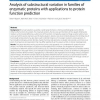Free Online Productivity Tools
i2Speak
i2Symbol
i2OCR
iTex2Img
iWeb2Print
iWeb2Shot
i2Type
iPdf2Split
iPdf2Merge
i2Bopomofo
i2Arabic
i2Style
i2Image
i2PDF
iLatex2Rtf
Sci2ools
BMCBI
2010
2010
Analysis of substructural variation in families of enzymatic proteins with applications to protein function prediction
Background: Structural variations caused by a wide range of physico-chemical and biological sources directly influence the function of a protein. For enzymatic proteins, the structure and chemistry of the catalytic binding site residues can be loosely defined as a substructure of the protein. Comparative analysis of drug-receptor substructures across and within species has been used for lead evaluation. Substructure-level similarity between the binding sites of functionally similar proteins has also been used to identify instances of convergent evolution among proteins. In functionally homologous protein families, shared chemistry and geometry at catalytic sites provide a common, local point of comparison among proteins that may differ significantly at the sequence, fold, or domain topology levels. Results: This paper describes two key results that can be used separately or in combination for protein function analysis. The Family-wise Analysis of SubStructural Templates (FASST) method...
Related Content
| Added | 08 Dec 2010 |
| Updated | 08 Dec 2010 |
| Type | Journal |
| Year | 2010 |
| Where | BMCBI |
| Authors | Drew H. Bryant, Mark Moll, Brian Y. Chen, Viacheslav Fofanov, Lydia E. Kavraki |
Comments (0)

